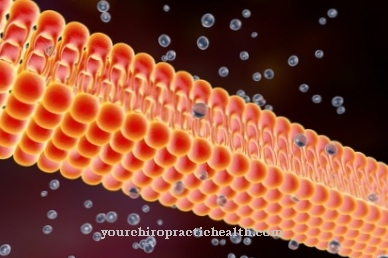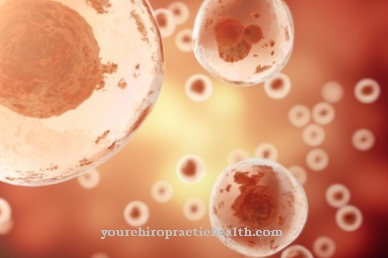The Vasodilation is a widening of the vessels by relaxing the vascular muscles. These smooth muscles are controlled by the two antagonists sympathetic and parasympathetic in the autonomic nervous system. In anaphylactic (allergic) shock there is vasodilation of life-threatening proportions.
What is vasodilation?

The autonomic nervous system controls a large number of vital body processes. The heartbeat, digestion, metabolism or blood pressure cannot be deliberately influenced, but are all controlled by higher-level brain centers and hormones.
Nerve impulses quickly adapt the organ functions to changed circumstances. The nerve tracts of the antagonists, the sympathetic and parasympathetic nerves, determine the activities of the autonomic nervous system. They lead from the central nervous system to the individual organs.
All involuntarily controlled nerve fibers are called visceromotor nerve fibers and are subject to either parasympathetic or sympathetic control. The vascular system contains both visceromotor fibers of sympathetic and parasympathetic control.
Vasodilation is the involuntary relaxation of the smooth vascular muscles, which is caused indirectly by the parasympathetic nervous system. The relaxation of the muscles widens the vessels and thus increases the blood flow. The opposite of this relaxation process is vasoconstriction, which is carried out by the sympathetic nervous system and which causes the vascular muscles to tighten. The lumen of the vessels is thus narrowed and the blood flow decreases.
Function & task
Vasodilation and vasoconstriction are vital processes of the autonomic nervous system. They adapt the blood flow to changing circumstances and are therefore necessary to maintain the circulation. Too sudden blood flow could overload the heart. Insufficient blood flow could cause tissues or internal organs to perish due to an insufficient supply of oxygen.
The adjustment of the blood flow to a given situation does not have to be decided consciously, but takes place automatically. This automatic system is particularly helpful for reacting as quickly as possible to changed situations. The active control of the smooth vascular muscles lies mainly in the sympathetic nervous system. It lets the muscles contract permanently. The parasympathetic nervous system is responsible for vasodilation. Since it appears as an opponent of the sympathetic, it has an inhibiting effect on the influence of the sympathetic. This inhibition can weaken or invalidate the command of the sympathetic to contract. The vascular muscles relax and the blood vessels enlarge their lumen. This increases the blood flow.
Vasodilation can be induced both actively and passively. The relaxation of the vascular muscles is an active procedure. Passive vasodilation, on the other hand, occurs when the blood volume increases. In active vasodilation, the interaction of nerves and muscles is called vasomotor functions.
In addition to the visceromotor fibers, vasodilation is also controlled via local mediators. Bradykinin, acetylcholine or endothelin act as such mediators and stimulate the endothelial receptors. As such, the B2, M3 and ET-B receptors are combined. These receptors respond to the stimulation with the formation of nitric oxide and prostacyclin. The parasympathetic nervous system perceives the increased nitrogen monoxide concentration as a request to inhibit the sympathetic nervous system. In this way, it influences the sympathetic nervous system and allows the vessels to relax.
The role of nitric oxide is evident in flow-mediated vasodilation, which is triggered by flow-induced shear forces. The prerequisite for flow-mediated vasodilation is the work of the endothelium. The activation of endothelial potassium channels allows potassium to flow out, causing hyperpolarization. Calcium flows in and activates endothelial nitric oxide synthases.
Illnesses & ailments
One of the most common ailments associated with vasodilation and vasoconstriction is migraine headache. Inadequate vasodilation of the cerebral vessels triggers this type of headache. Vasodilatations can be caused by vasoactive substances or relaxation training such as autogenic training, which can alleviate the headache.
Damage to the endothelium can also be associated with vasodilation disorders. For example, if the endothelium can no longer perceive shear forces, its potassium channels will not open and nitric oxide synthases will not be activated in sufficient quantities. The flow-mediated vasodilation is therefore often determined clinically in order to draw conclusions about the activity of the endothelium.
Discomfort and complications caused by vasodilation can also occur in the context of allergic reactions. In the case of vasodilation, histamine can be released. This substance not only dilates the blood vessels, it also reddens the skin and, in extreme cases, can trigger an anaphylactic shock. Anaphylactic shock can lead to circulatory collapse and organ failure. The immune system reacts to chemical substances, for example. The increased release of mediators constrict the bronchi and cause gastrointestinal symptoms.
This systemic reaction of the whole organism is potentially life threatening. It causes the blood pressure to drop sharply because of the widening of the vessels. Fluid escapes from the vessels into the surrounding tissue. The pulse drops and loss of consciousness occurs. The initial symptoms are relatively unspecific and range from vomiting, visual disturbances and dry mouth to dyspnoea and circulatory problems.
Anaphylactic shock can ultimately trigger cardiovascular and respiratory arrest. This life-threatening situation can only be reversed through rapid resuscitation. Adrenaline and similar substances may relieve the acute symptoms. Glucocorticoids and antihistamines or H2-receptor antagonists can also improve the patient's condition.






.jpg)

















.jpg)



